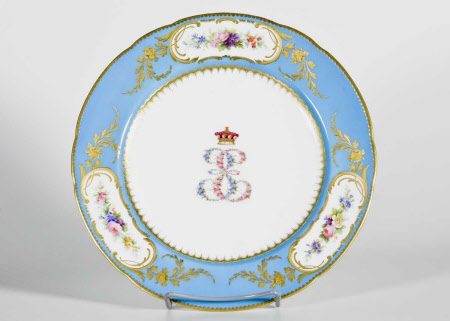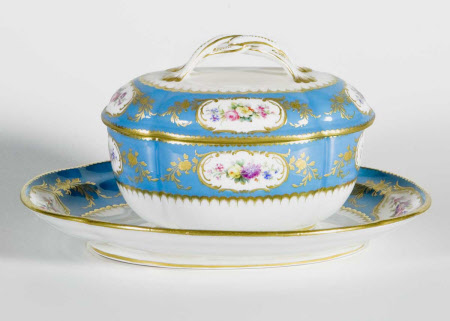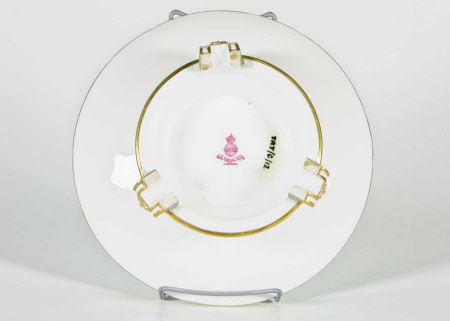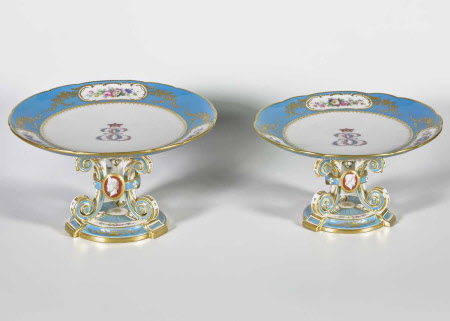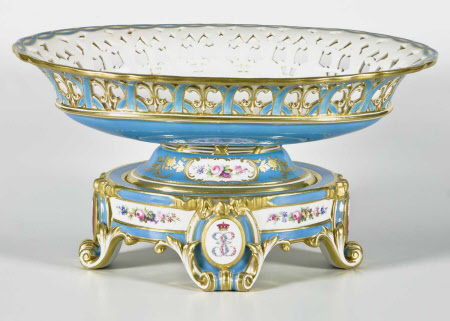Dessert service
Minton's Ltd (Minton and Co.)
Category
Ceramics
Date
1863 - 1882
Materials
bone china and unglazed porcelain (Parian), polychrome enamels, gold
Place of origin
England
Order this imageCollection
Tatton Park, Cheshire
NT 1296712
Summary
Dessert service, bone china, painted in the Sèvres style with bouquets on a turquoise (bleu céleste) ground, gilt enclosures, flower garland entwined cipher 'E.E' under a baron’s coronet, printed mark in puce of a crown above ‘T.Goode & Co./London/Minton’s China’, impressed date codes for 1863, 1864, 1865, 1881 and 1882, ‘Minton’ and ‘Mintons’, comprising; four ice pails with ram’s head handles and swags (TAT/C/63), two large oval compotes and stands, thirty-four plates, two sucriers (sauceboats) and covers, nine tall compotes (originally ten) and four low compotes, a pair of four-light candelabra and a six-light candelabrum (TAT/C/66).
Full description
The sale to Queen Victoria at the 1851 Great Exhibition of a spectacular 116-piece turquoise-ground dessert service secured the luxury tablewares market for the Staffordshire-based pottery Minton & Co. for the following two decades. The official exhibition catalogue announced that 69 pieces of the ‘Victoria’ service, as it became known – purchased at the preview for 1,000 guineas – had been given by Her Majesty to the Emperor of Austria. Each piece was individually painted with cupids, flowers or fruit against a vibrant turquoise ground, imitating the famous bleu-céleste of the Sèvres factory. It received critical acclaim for its unique combination of glazed bone china with Parian (unglazed porcelain) statuary figures modelled by the French sculptor Pierre-Emile Jeannest (1813–57). One of the original guarantors for the exhibition, Herbert Minton (1793–1858), son of the manufactory’s founder, had carefully engineered the firm’s success. In 1848 he had hired a Sèvres-trained potter, Joseph-François-Léon Arnoux (1816–1902), as artistic director. By 1851 there were 10,000 tableware patterns and 600 models in the Minton design books. Many of their most innovative ceramics were launched at the Great Exhibition, and even after it closed, duplicates were displayed at the Museum of Manufactures at Marlborough House, London. Queen Victoria went on to order Minton turquoise-ground services for Windsor Castle and Balmoral, influencing the purchases of England’s aristocratic consumers, such as Col. Edward Gordon Douglas-Pennant (1800–86), later 1st Baron Penrhyn, who in 1859 ordered a Victoria service for Penrhyn Castle, Gwynedd (NT). In 1864-5, the politician William Tatton Egerton (1806–83), created 1st Baron Egerton of Tatton in 1859, ordered a large Minton turquoise-ground dessert service with a double ‘E’ cipher under a baron’s coronet, of which 57 pieces survive at Tatton Park, Cheshire. The pattern on the 34 plates closely imitates the Vincennes-Sèvres taste for bouquets in reserves on a bleu céleste ground. In addition to oval cream bowls and four ice pails with ram’s head handles. In 1883 the service was enlarged by Egerton’s son Wilbraham (1832–1909), created Viscount Salford and Earl Egerton in 1897. He placed his orders for a pair of four-light candelabra, a single six-light candelabrum and compotes through the influential London china retailer Thomas Goode & Co. on South Audley Street, whose name is on the backstamp. Minton worked closely with William James Goode (1831–92), the then owner, a talented designer and painter, who also collected eighteenth-century Sèvres porcelain. Goode & Co. supplied the gentry with all their ceramic needs from Minton and other manufacturers, lavishly painted with bespoke crests and ciphers. The additions to the Egerton service are embellished also with portrait cameos en grisailles, after the neoclassical service made at Sèvres for Catherine II of Russia in 1777–9.8 Elements of the Russian service were in London by the 1840s in the collection of William Lowther, 2nd Earl of Lonsdale (1787–1872), and are now in the Wallace Collection, London. Text adapted from Patricia F. Ferguson, Ceramics: 400 Years of British Collecting in 100 Masterpieces, Philip Wilson Publishers, 2016.
Marks and inscriptions
EE (monogram); T. Goode & Co. / London / Minton's China (printed maker's mark in puce surmounted by a crown); 1863; 1864; 1865; 1881; 1882 (impressed date marks); Minton; Mintons (impressed?)
Makers and roles
Minton's Ltd (Minton and Co.) , manufacturer
References
Ceramics: 400 Years of British Collecting in 100 Masterpieces, Philip Wilson Publishers, 2016, 194-5


